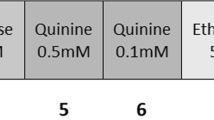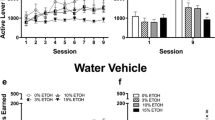Abstract
Studies of inbred strains of rats and mice have suggested a positive association between strain variations in sweet taste and ethanol intake. However, strain associations by themselves are insufficient to support a functional link between taste and ethanol intake. We used conditioned taste aversion (CTA) to explore the sweet and bitter taste of ethanol and ability to detect sucrose, quinine and ethanol in C57BL/6J (B6) and DBA/2J (D2) mouse strains that are frequently used in alcohol research. The present study showed that C57BL/6J mice generalized taste aversions from sucrose and quinine solutions to 10% ethanol and, reciprocally, aversions to 10% ethanol generalized to each of these solutions presented separately. Only conditioned aversions to quinine generalized to ethanol in the DBA/2J strain but an aversion conditioned to ethanol did not generalize reciprocally to quinine. Thus, considering these two gustatory qualities, 10% ethanol tastes both sweet and bitter to B6 mice but only bitter to D2. Both strains were able to generalize taste aversions across different concentrations of the same compound. B6 were able to detect lower concentrations of quinine than D2 but both strains were able to detect sucrose and (in contrast to previous findings) ethanol at similar concentrations. The strain-dependent gustatory profiles for ethanol may make an important contribution to the understanding of the undoubtedly complex mechanisms influencing high ethanol preference of B6 and pronounced ethanol avoidance of D2 mice.








Similar content being viewed by others
Reference
Adams N, Shihabi Z, Blizard DA (1991) Ethanol preference in the Harrington derivation of the Maudsley Reactive and Non-Reactive strains. Alcohol Clin Exp Res 15:170–174
Bachmanov AA, Tordoff MG, Beauchamp GK (1996a) Ethanol consumption and taste preferences in C57BL/6ByJ and 129/J mice. Alcohol Clin Exp Res 20:201–206
Bachmanov AA, Reed DR, Tordoff MG, Price RA, Beauchamp GK (1996b) Intake of ethanol, sodium chloride, sucrose, citric acid, and quinine hydrochloric solutions by mice: a genetic analysis. Behav Genet 26:563–573
Bachmanov AA, Kiefer SW, Molina JC, Tordoff MG, Duffy VB, Bartoshuk LM, Mennella JA (2003) Chemosensory factors influencing alcohol perception, preferences and consumption. Alcohol Clin Exp Res 27:220–231
Badia-Elder NE, Kiefer SW (1999) Taste reactivity in alcohol-preferring AA and alcohol-avoiding ANA rats. Alcohol 18:159–163
Belknap JK, Belknap ND, Berg JH, Coleman R (1977) Preabsorptive vs postabsorptive control of ethanol intake in C57BL/6J and DBA/2J mice. Behav Genet 7:413–425
Belknap JK, Coleman RR, Foster K (1978) Alcohol consumption and sensory threshold differences between C57BL/6J and DBA/2J mice. Physiol Psychol 6:71–74
Belknap JK, Crabbe JC, Young ER (1993) Voluntary consumption of ethanol in 15 inbred mouse strains. Psychopharmacology 112:503–510
Bice P, Foroud T, Bo R, Castelluccio P, Lumeng L, Li TK, Carr LG (1998) Genomic screen for QTLs underlying alcohol consumption in the P and NP rat lines. Mamm Genome 9:949–955
Blizard DA (1992) Analyzing phenotypic correlations in studies with selected lines. Behav Genet 22:29–33
Blizard DA (1998) Chromosomal location of genes affecting gustation. Renewal of R01DC002230, July 1st 1998
Blizard DA, Chang A, DiFabio B, Taylor BA (1977) Genetic analysis of taste preference. Eastern Psychological Association, Boston, Massachusetts
Blizard DA, Kotlus B, Frank ME (1999) Quantitative trait loci (QTL) associated with short-term intake of sucrose, saccharin and quinine solutions in laboratory mice. Chem Senses 24 373–385
Blizard DA, McClearn GE (2000) Association between ethanol and sucrose intake in the laboratory mouse: exploration via congenic strains and conditioned taste aversion. Alcohol Clin Exp Res 24:253–258
Broadbent J, Muccino KJ, Cunningham CL (2002) Ethanol-induced conditioned taste aversion in 15 inbred mouse strains. Behav Neurosci 116:138–148
Clarke SN, Koh MT, Bernstein IL (2001) NaCl detection thresholds: comparison of Fischer 344 and Wistar rats. Chem Senses 26:253–257
Cooper CW (1966) The relationship of taste sensitivity to taste preference for two non-nutritive substances in two inbred strains of mice and their hybrid. Smith College Department of Psychology Honor’s thesis
Dess NK, Badia-Elder NE, Thiele TL, Kiefer SW, Blizard DA (1998) Ethanol consumption in rats selectively bred for differential saccharin intake. Alcohol 16:275–278
DiLorenzo PM, Kiefer SW, Rice AG, Garcia J (1986) Neural and behavioral responsivity to ethyl alcohol as a tastant. Alcohol 3:55–61
Duffy VB, Davidson AC, Kidd JR, Kidd KK, Speed WC, Pakstis AJ, Reed DR, Snyder DJ, Bartoshuk LM (2004) Bitter receptor gene (TAS2R38) 6-n-propylthiouracil (PROP) bitterness and alcohol intake . Alcohol Clin Exp Res 28:1629–1637
Eriksson K, Rusi M (1981) Finnish selection studies on alcohol-related behaviors: general outline, In: McClearn GE, Deitrich RA, Erwin EG (eds) Development of animal models as pharmacogenetic tools. US DHHS Publications, Washington DC, pp 87–117
Frank ME, Formaker BK, Hettinger TP (2003) Taste responses to mixtures: analytic processing of quality. Behav Neurosci 117:228–235
Frank ME, Nowlis GH (1989) Learned aversions and taste qualities in hamsters. Chem Senses 14:379–394
Fuller JL (1974) Single locus control of saccharin preference in mice. J Hered 65:33–36
Grill HJ, Norgren R (1978) The taste reactivity test I Mimetic responses to gustatory stimuli in neurologically normal rats. Brain Res 143:263–279
Harder DB, Capeless CG, Maggio JC, Boughter JD, Gannon KS, Whitney G, Azen EA (1992) Intermediate sucroseoctaacetate sensitivity suggests a third allele at mouse bitter taste locus Soa and Soa–Rua identity. Chem Senses 17:391–401
Henderson ND (1989) Interpreting studies that compare high- and low-selected lines on new characters. Behav Genet 19:473–502
Kampov-Polevoy AB, Garbutt JC, Janowsky DS (1999) Association between preference for sweets and excessive alcohol intake: a review of animal and human studies. Alcohol Alcohol 34:386–395
Kiefer SW (1995) Alcohol, palatability and taste reactivity. Biobehav Rev 19:133–141
Kiefer SW, Lawrence GJ (1988) The sweet-bitter taste of alcohol: aversion generalization to various sweet–quinine mixtures in the rat. Chem Senses 13:633–641
Kiefer SW, Mahadevan RS (1993) The taste of alcohol for rats as revealed by aversion generalization tests. Chem Senses 18:509–522
Kiefer SW, Morrow NS, Metzler CW (1988) Alcohol aversion generalization in rats: specific disruption of taste and odor cues with gustatory neocortex or olfactory bulb ablations. Behav Neurosci 102:733–739
Kotlus BS, Blizard DA (1998) Measuring gustatory variation in mice: a short-term fluid-intake test. Physiol Behav 64:37–47
Lawrence GJ, Kiefer SW (1987) Generalization of specific taste aversions to alcohol in the rat. Chem Senses 12:591–599
Lemon CH, Brasser SM, Smith DV (2004) Alcohol activates a sucrose-responsive gustatory neural pathway. J Neurophysiol 92:536–544
Li T-K, Lumeng L, McBride WJ, Waller MB (1981) Indiana selection studies on alcohol-related behaviors, In: McClearn GE, Deitrich RA, Erwin EG (eds) Development of animal models as pharmacogenetic tools. US DHHS Publications, Washington DC, pp 171–191
Li T-K, Lumeng L (1984) Alcohol preference and voluntary alcohol intakes of inbred rat strains and the National Institutes of Health heterogeneous stock of rats. Alcohol Clin Exp Res 8:485–486
Lush IE (1984) The genetics of tasting in mice III Quinine. Genet Res (Camb) 44:151–160
Lush IE (1989) The genetics of tasting in mice VI Saccharin, acesulfame, dulcin and sucrose. Genet Res (Camb) 53:95–99
MacKinnon BI, Frank ME, Hettinger TP, Rehnberg BG (1999) Taste qualities of solutions preferred by hamsters. Chem Senses 24:23–35
McClearn GE, Rodgers DA (1959) Differences in alcohol preference among inbred strains of mice. Quart J Stud Alcohol 20:691–695
Nachman M, Larue C, Le Magnen J (1971) The role of olfactory and orosensory factors in the alcohol preference of inbred strains of mice. Physiol Behav 6:53–59
Ninomiya K, Funakoshi M (1988) Behavioral discrimination between glutamate and the four basic taste substances in mice Comp. Biochem Physiol 92A:365–370
Overstreet DH, Kampov-Polevoy AB, Rezvani AH, Murrelle L, Halikas JA, Janowsky DS (1993) Saccharin intake predicts ethanol intake in genetically heterogeneous rats as well as different rat strains. Alcohol Clin Exp Res 17:366–369
Peirce JL, Derr R, Shendure J, Kolata T, Silver LM (1998) A major influence of sex-specific loci on alcohol preference in C57BL/6J and DBA/2J inbred mice. Mamm Genome 9:942–948
Pelchat ML, Danowski S (1992) A possible genetic association between PROP-tasting and alcoholism. Physiol Behav 51:1261–1266
Pelz W, Whitney G, Smith JC (1973) Genetic influences on saccharin preferences in mice. Physiol Behav 10:263–265
Phillips TJ, Crabbe JC, Metten P, Belknap JK (1994) Localization of genes affecting alcohol drinking in mice. Alcohol Clin Exp Res 18:931–941
Phillips TJ, Belknap JK, Buck KJ, Cunningham CL (1998) Genes on mouse chromosomes 2 and 9 determine variation in ethanol consumption. Mamm Genome 9:936–941
Rodgers DA, McClearn GE (1964) Sucrose versus ethanol appetite in inbred strains of mice. Quart J Stud Alcohol 25:26–35
Rodgers DA (1966) Alcohol preference in mice. In: Zubin J (eds) Comparative psychopathology—animals humans. Grune, New York
Rodriguez LA, Plomin R, Blizard DA, Jones BC, McClearn GE (1994) Alcohol acceptance, preference, and sensitivity in mice: I Quantitative genetic analysis using BXD recombinant-inbred strains. Alcohol Clin Exp Res 18:1416–1422
Rodriguez LA, Plomin R, Blizard DA, Jones BC, McClearn GE (1995) Alcohol acceptance, preference, and sensitivity in mice: II Quantitative trait loci (QTL) mapping analysis using BXD recombinant-inbred strains. Alcohol Clin Exp Res 19:367–373
Sinclair JD, Kampov-Polevoy A, Stewart R, Li TK (1992) Taste preferences in rat lines selected for low and high alcohol consumption. Alcohol 9:155–160
Stewart RB, Russell RN, Lumeng L, Li T-K, Murphy JM (1994) Consumption of sweet, salty, sour, and bitter solutions by selectively bred alcohol-preferring and alcohol non-preferring lines of rats. Alcohol Clin Exp Res 18:375–381
Tarantino LM, McClearn GE, Rodriguez LA, Plomin R (1998) Confirmation of quantitative trait loci for alcohol preference in mice. Alcohol Clin Exp Res 22:1099–1105
Thomas K (1969) Selection avoidance of alcohol solutions by two strains of inbred mice and derived generations. Quart J Stud Alcohol 30:849–861
Thompson WR (1957) Traits, factors and genes. Eugen Q 4:8–16
Acknowledgments
This research was supported in part by Grants DC-02230 and AA-14711 to David A. Blizard, AA-08454 to Gerald E. McClearn and DC-004099 to Marion E. Frank. I appreciate the comments of Marion E. Frank and Gerald E. McClearn on this manuscript and the assistance of MEF with graphic presentation. I dedicate this paper to Candace W. Cooper and John L. Fuller (in memoriam) for their seminal work on saccharin preference at the Jackson Laboratory.
Author information
Authors and Affiliations
Corresponding author
Additional information
Edited by Andrew Holmes and Stephen Maxson
Sweet and bitter are used to refer to a variety of solutions that are labeled by those descriptors by humans. In adopting this usage, it is not assumed that these substances produce the same sensation/perception in laboratory rats and mice.
Rights and permissions
About this article
Cite this article
Blizard, D.A. Sweet and Bitter Taste of Ethanol in C57BL/6J and DBA2/J Mouse Strains. Behav Genet 37, 146–159 (2007). https://doi.org/10.1007/s10519-006-9121-4
Received:
Accepted:
Published:
Issue Date:
DOI: https://doi.org/10.1007/s10519-006-9121-4




